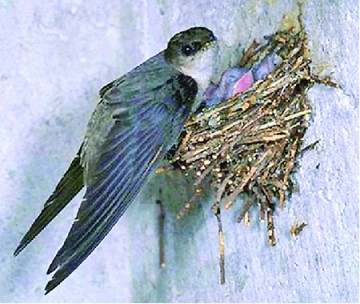Chimney Swifts
You hear them before you see them, as if they’re part of summer’s soundtrack. Chimney swifts, resembling flying cigars, chitter as they swoop and swerve overhead. Joan Cwi, past president of the Baltimore Bird Club, has studied these strange little birds for 20-plus years.
Share her inside knowledge in her photo- and video-illustrated talk, The Ordinary, Extraordinary Chimney Swift, Anne Arundel Bird Club’s March 20 program at Quiet Waters Park.
Bay Weekly It’s rare to see a chimney swift up close. When you did, what did you think?
Joan Cwi What a plain little bird! I was holding a fledgling swift brought down by Avian Haven, a bird rehabilitation center in Maine. Some hand-reared swiftlets were ready for release in the fall, but the swifts had already departed from Maine, and these had to be brought south for release where swifts were still migrating through. We tossed them into the air, and they circled low above us until about a thousand swifts swooped down from high above, incorporated the young ones and flew off. It was like a miracle.
Bay Weekly Do they really depend on chimneys?
Joan Cwi Yes. They nest in chimneys, and during migration huge numbers of swifts roost together. Chimney swifts historically nested in hollow trees and on cliffsides, but they have adapted to living in manmade structures. As they have tiny legs and long claws, they can’t perch or fly from the ground and can only cling to a vertical surface.
Bay Weekly Is their population stable?
Joan Cwi Chimney swift numbers rose because of increased habitat opportunity, but now they’ve dramatically declined. One reason is that insect numbers are down. Another is that many old chimneys have been capped or destroyed. They aren’t harmful to chimneys, but homeowners now often cap chimneys against bats and squirrels.

Bay Weekly Tell us about how they nest.
Joan Cwi Against a chimney wall, they build a half-cup nest made of little twigs that they catch with their feet and bind together with a sticky saliva. There’s only one nest per chimney. Helper swifts may be in the chimney to feed the three to five swiftlets, but don’t nest there themselves. The young have to be fed every 15 minutes, even at night. That’s why they have helpers.
Bay Weekly What do they eat?
Joan Cwi They go after aerial insects: gnats, midges, mosquitoes and even spiders. It’s believed they eat their weight in insects each day. Once they leave the chimney in the morning, they fly all day, coming back only to feed the babies, until it’s time to roost at dusk.
Bay Weekly What do we know about their migration?
Joan Cwi Chimney swifts are daytime migrants. They gather in huge numbers to migrate, roosting in large chimneys on their way to the Amazon basin, where they spend the winters.
Bay Weekly You and other Baltimore Bird Club members host a twice-yearly event, Chimney Swifts at Dusk …
Joan Cwi Yes, the Hampden Chimney Swift Watch happens during spring and fall migration. For years the birds have been regulars at the Hampden Bookbindery chimney. Up to 100 people gather to wait for the birds. At dusk they come in from all directions, and suddenly there’s a swirl above the chimney. Then a bird will take the lead, and they all funnel down the chimney. I’ll have a wonderful video of this at my talk.
Bay Weekly When is the next watch?
Joan Cwi Sunday, May 5, 7:45 to 8:30pm. We post information at baltimorebirdclub.org. If it’s cloudy or drizzling, come 30 minutes early. We cancel for rain.
Bay Weekly How can we help these birds?
Joan Cwi We can fight for more pesticide regulation. We can build swift towers to augment roosting and nesting places. Try to prevent large chimneys from being capped. I do that when I educate building owners about chimney swifts.
Get to know you chimney swifts: March 20, 7-9pm, Quiet Waters Park, Blue Heron Center; refreshments served: 410-703-4664.
